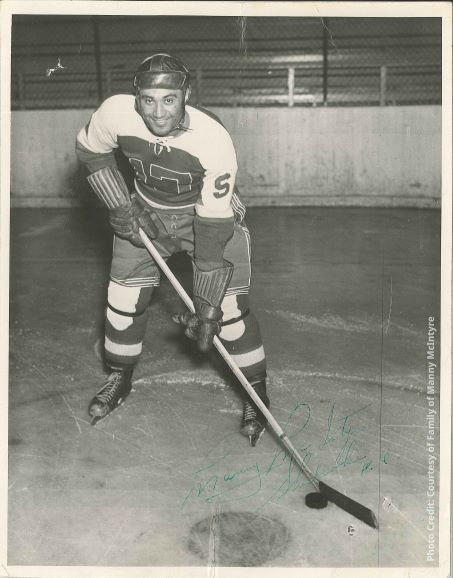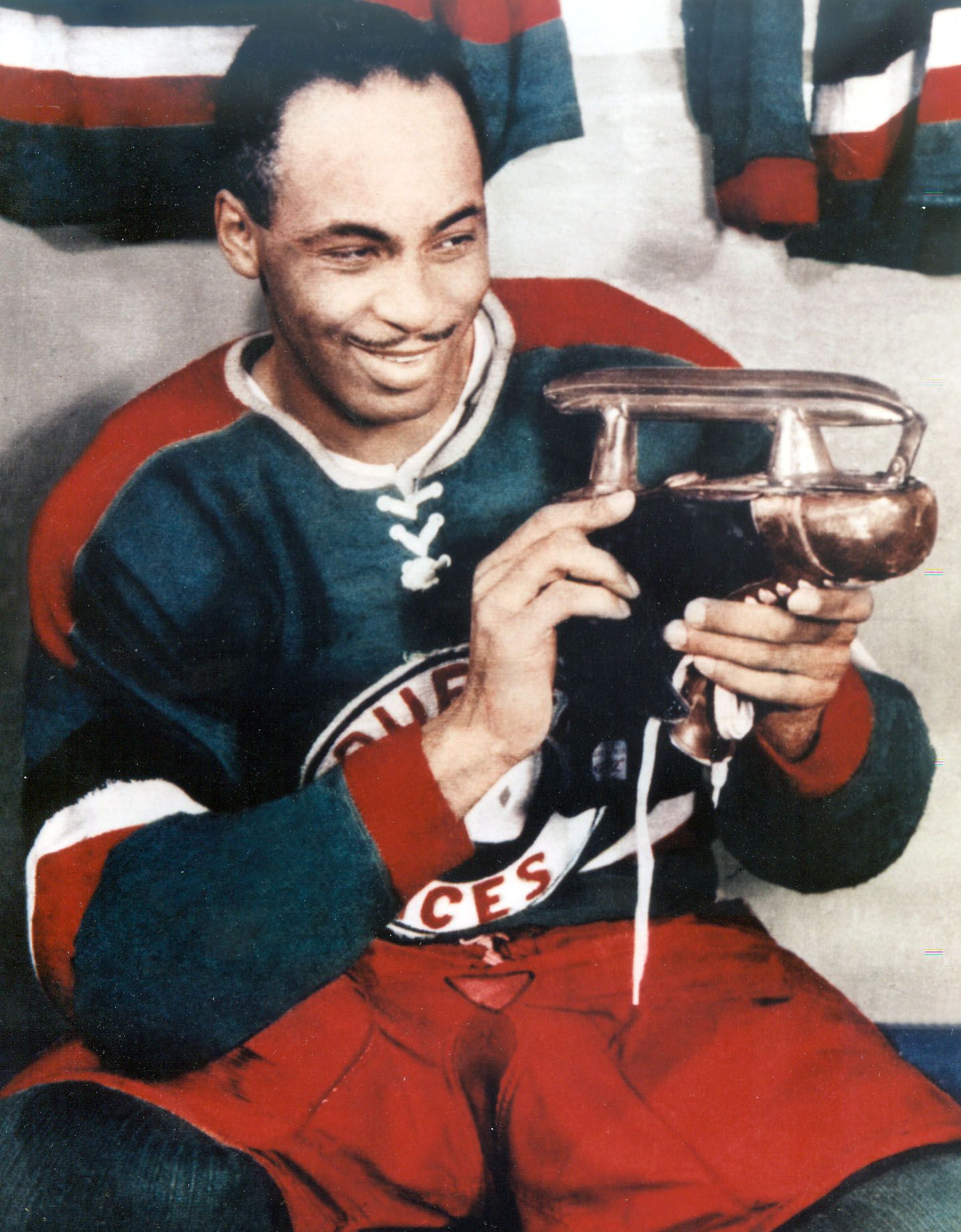
Canada's Sports Hall of Fame
The MOBILE MUSEUM EXPERIENCE celebrates hockey's TRAILBLAZERS, CHANGEMAKERS, BUSINESS LEADERS & COLLECTORS spanning across multiple underrepresented and multicultural demographics. By raising awareness and education of diverse individuals within the game of hockey, the museum truly highlights the fact that HOCKEY IS FOR EVERYONE!
As Canada’s national museum of sport, we are honoured to partner with the NHL and their United by Hockey Mobile Museum to spotlight five (5) Order of Sport recipients and Hall of Famers featured in the mobile museum. We invite you to learn more about the lineup of Ice Hockey icons who have been inducted into Canada’s Sports Hall of Fame and the free education programs, artefacts, and resources featuring their remarkable stories.
THE LINEUP
Willie O'Ree
"Manny" McIntyre
Herb Carnegie
Bryan Trottier
Angela James
Want to connect to more stories of trailblazing athletes and builders of sport?

#118828631 RR0001
Courtesy of Canada’s Sports Hall of Fame Collections.
Ice hockey is a contact team sport where two teams of five and a goaltender play each other on an ice surface. Players compete for the puck and try to score past the goalie in the net.
Tom Longboat Award

Angela James

Date of Birth: December 22, 1964
Member Category: Athlete
Pioneers are made of tough stuff. No one knows this better than one of Canada's greatest ice hockey players, Angela James. A four-time world champion in
women's ice hockey who also won a world championship in roller hockey, James
was a brilliant goal scorer who was among the first women inducted into the
Hockey Hall of Fame alongside Cammi Granato in 2010. A respected role model,
the Toronto community she grew up in has named a local hockey rink the Angela
James Arena.
Learn more
Photograph
of Angela James and Geraldine Heaney holding the 3 Nations Cup.
Photo credit: Order of Sport Collection/Canadian Museum of History

Herb Carnegie

Date of Birth: January 18, 1919
Member Category: Athlete
Herb Carnegie was likely one of the best ever players to never play pro-league hockey. He starred in Quebec senior hockey leagues in the 1940s and '50s. A smooth skating centre, Carnegie trained hard and following an outstanding junior career joined the Perron Flyers in Northern Quebec, eventually landing with Shawinigan Falls in the Quebec Provincial League before moving to Sherbrooke. With the Sherbrooke Saints, Carnegie, his brother Ossie, and a third black player, Manny McIntyre from Fredericton, formed one of the most successful lines in league history. Learn more
Willie O'Ree

Date of Birth: October 15, 1935
Member Category: Builder
Willie O’Ree discovered his extraordinary passion for ice hockey at an early age, practicing on a homemade rink in his backyard and skating to school whenever the weather allowed. Growing up in one of only two black families in Fredericton in the 1930’s, Willie began to dream when he was 14 years old of playing ice hockey professionally in the National Hockey League (NHL). This was a goal that demanded tremendous courage, drive and perseverance, as no black athlete had ever played in the NHL before. Learn more
Willie O'Ree's Boston Bruins & Hockey Hall of Fame Commemorative Rings

Bryan Trottier

Date of Birth: July 17, 1956
Member Category: Athlete
In the world of ice hockey, Bryan Trottier’s accomplishments
are legendary. What makes those accomplishments even more spectacular is where
it all humbly began, out on the freshly flooded pond made by a beaver dam.
Bryan remembers learning how to skate and shoot just like all the other kids,
spending hours honing the skills that would eventually help him become a hockey
superstar.
Fondly nicknamed “Trots” Bryan’s accomplishments over the
years have made him legendary both on and off the ice. As a major junior
player, he was named Most Valuable Player for both the Western Canadian Hockey
League and the World Hockey Championships during the 1974-1975 season. At 18,
the NHL’s New York Islanders drafted Bryan. Over an 18-year career, led his
teams to the Stanley Cup six times, 1980-1983, 1991, 1992 adding a Stanley Cup
win as an Assistant Coach in 2001.
Learn more
Bryan Trottier won the Stanley Cup six times during his career as a player and coach.
Courtesy of Bryan Trottier

The last jersey worn as a New York Islander in 1990; worn when Bryan Trottier scored his 500th goal.
Courtesy Bryan Trottier

Vincent Churchill "Manny" McIntyre

Date of Birth: October 4, 1918
Member Category: Athlete
Vincent Churchill "Manny" McIntyre challenged the racial barriers within his chosen sports of baseball and ice hockey. In 1946, Manny became the first black Canadian to sign a professional baseball contract with the St. Louis Cardinals farm team the Sherbrooke Canadiens. While taking a job working in the mines, Manny also began to play competitive hockey in the Northern Ontario League. He was a part of the first all-black line in professional hockey known as “The Black Aces.” Learn more
Herb Carnegie

Date of Birth: November 8th, 1919
Member Category: Athlete
Herb
Carnegie, who starred in the Quebec senior hockey leagues in the 1940s and
‘50s, was likely one of the best players to never play in the National Hockey
League. A smooth-skating center, Carnegie trained hard and following an
outstanding junior career joined the Perron Flyers in Northern Ontario, before
eventually landing with Shawinigan Falls and then Sherbrooke in the Quebec
Provincial League. With the Sherbrooke Saints, Carnegie, his brother Ossie, and
a third black player, Manny McIntyre from Fredericton, formed one of the most
successful lines in league history. Learn more
Herb Carnegie donning his red, black, white and
blue Quebec Aces jersey in the team locker room.
Photo Credit: Order of Sport Collection/Canadian Museum of History

Herb Carnegie on an ice rink in full
Quebec Aces uniform.
Photo Credit: Order of Sport Collection/Canadian Museum of History


Submit your application to be part of Canada's Sports Hall of Fame's Educator Advisory Committee and help shape meaningful sport education programs that inspire and engage students across Canada.
Courtesy of Order of Sport collection, Canadian Museum of History.
2. Consider analyzing materials (i.e., is it wood, stone, plastic, etc.?)
4. Are there any inscriptions (i.e., are there any markings that are printed, stamped, engraved)?
5. What symbolism do you see?
6. How is the object oriented? (i.e., Does it have a presumed front, back, bottom, or top?)
7. What features do you think it might share with similar objects?
8. Does the object prompt some kind of action or performance?
9. What is this artefact?
10. What stories or information do you think it tells?
Rowing is the propelling of a boat using a fixed oar as a lever. In modern sports, rowers race against each other as individuals or in crews of two, four or eight.
Courtesy of Order of Sport collection, Canadian Museum of History.
2. Consider analyzing materials (i.e., is it wood, stone, plastic, etc.?)
4. Are there any inscriptions (i.e., are there any markings that are printed, stamped, engraved)?
5. What symbolism do you see?
6. How is the object oriented? (i.e., Does it have a presumed front, back, bottom, or top?)
7. What features do you think it might share with similar objects?
8. Does the object prompt some kind of action or performance?
9. What is this artefact?
10. What stories or information do you think it tells?
Rowing is the propelling of a boat using a fixed oar as a lever. In modern sports, rowers race against each other as individuals or in crews of two, four or eight.
Courtesy of Order of Sport collection, Canadian Museum of History.
2. Consider analyzing materials (i.e., is it wood, stone, plastic, etc.?)
4. Are there any inscriptions (i.e., are there any markings that are printed, stamped, engraved)?
5. What symbolism do you see?
6. How is the object oriented? (i.e., Does it have a presumed front, back, bottom, or top?)
7. What features do you think it might share with similar objects?
8. Does the object prompt some kind of action or performance?
9. What is this artefact?
10. What stories or information do you think it tells?
Rowing is the propelling of a boat using a fixed oar as a lever. In modern sports, rowers race against each other as individuals or in crews of two, four or eight.

